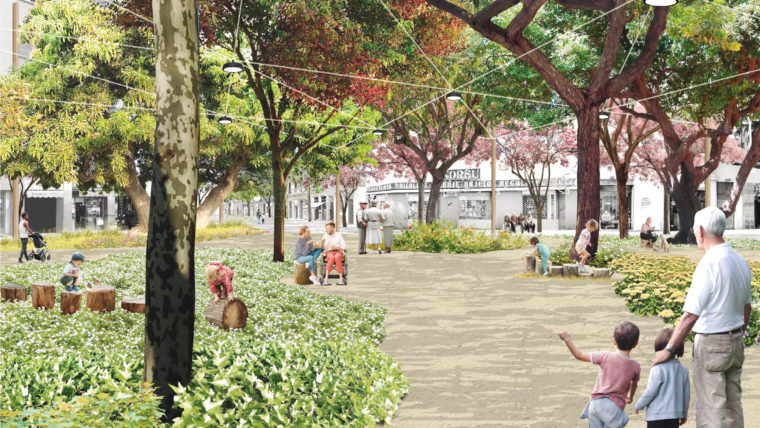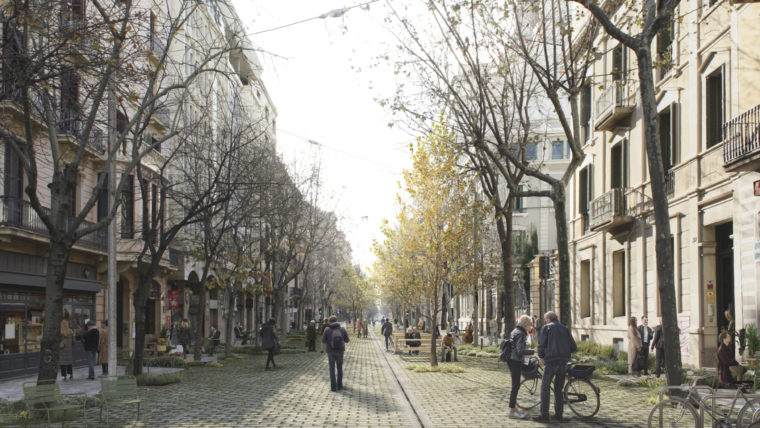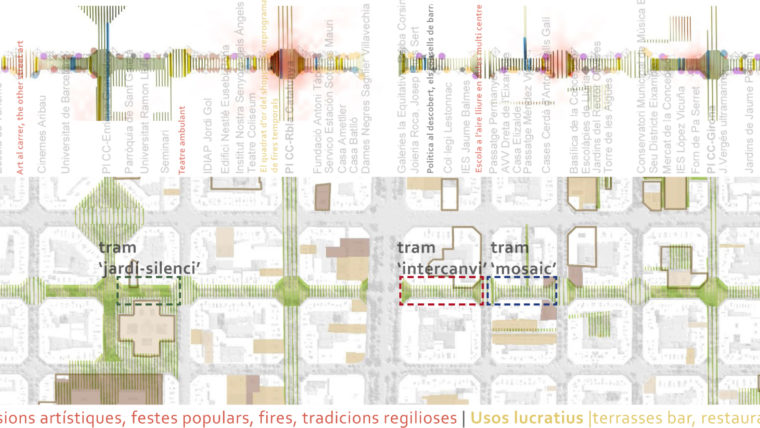Ideas contest to design the Barcelona Superblock resolved
Eight winning projects have now been chosen from the 86 entered in the ideas contest which will shape the Barcelona Superblock, the new urban model for a closer, healthier and more human city. The designs for the four squares were chosen for their suitability to each location, with ample vegetation and areas for people to relax and play in. The projects chosen for the green streets offer the best definition of what a 21st century street should be like: absolute priority for pedestrians, universal access and sustainability criteria. Citizens will be involved in the definition of the final projects.
The winning projects for the squares are:
- Consell de Cent with Rocafort, “The parliament of species”, by the team Estudi08014 – Arquitectura, ciutat, territori, SCPP: concentric spatial layout of the square with vegetation in the centre and paving around it. With its permeable paving, vegetation and shade, the design helps keep temperatures and pollution down.
- Consell de Cent with Comte Borrell, “Block of blocks”, presented by the joint venture between Clara Solà-Morales, Albert Casas Álvarez and Frederic Villagrasa Álvarez: visually clean and versatile, accommodating the uses currently made by local people. In the centre, an area for people to relax in with sixteen trees.
- Consell de Cent with Enric Granados, “Garden block”, by the joint venture GPO Ingeniería y Arquitectura SLU and Land Lab, Laboratorio de Paisajes SL: proposal to enlarge the garden of the Seminari building, making it asymmetric and more natural. The garden will be part of the green space running from the university gardens to Plaça de Letamendi.
- Consell de Cent with Girona, “Super-treebed”, by the joint venture between Under Project Lab SCP and Bopba Arquitectura SLP: conditioned by the metro station, this project concentrates the permeable and green section on the side nearest the mountains. The part with less nature will be used for areas for people to relax and play in.
What will the green streets be like?
For the green streets, the jury selected four winning projects reflecting the values which the new street model must include. The winning teams will now draft a document together to define what the green streets should be like, based on:
- Pedestrians as the absolute protagonists, with straight continuous routes guaranteed.
- Only private vehicles with the street as their final destination can circulate there, at 10 km/h.
- Streets to have curbless paving and guarantee universal access.
- Paving with recycled material to substitute asphalt, with an eruption of greenery, particularly in the corners of squares.
- Green streets to foster life in the neighbourhood, with zones for people to relax in, meet up and play in, local commerce, with pleasant spaces and areas for loading/unloading and waste.
- Sustainable new street model to make use of rainwater, include solar panelling to make streetlighting self-sufficient and feature used materials to cut emissions that cause climate change.
The winning projects, whose teams will work together to design the new street model on under these premises, are:
- “Walking from the centre”. Team: Joint venture between B67 Palomeras Arquitectes SLP and Cierto Estudio SCCLP
- “Plot to plot (invariants and variants)”. Team: Joint venture between Esteyco – Arquitectura, Estudi Martí Franch Arquitectura del Paisatge and Nablabcn Studio
- “Greenspin”. Team: Joint venture between González Cavia, Cabrera Arquitectura Urbanismo y Paisaje SL and Fabric Office SCCLP
- “Galleries of life”. Team: Joint venture between GPO Ingeniería y Arquitectura SLU, Agence Ter SARL and Ana Coello de Llobet SLP.
Participatory process and calendar
The participatory process is open to citizens in three stages:
- February-May 2021: sessions to define the model for green streets
- June-October 2021: follow-up for draft projects
- October-March 2023: finalisation of projects and monitoring of work
The initial calendar is for work to conclude in the first quarter of 2023:
- February 2022: executive projects finalised
- June 2022: work to begin
- First quarter of 2023: completion of work
What is the Barcelona Superblock and how will it be implemented?
The Barcelona Superblock is a new city model aimed at regaining streets for citizens. It will be applied in all districts but gets under way in L’Eixample, the densest district with the most pollution and noise, with four roads to be transformed into green streets and four junctions into squares of 2,000 square metres.
The model will be rolled out in the rest of L’Eixample in the future so that one in three roads become green streets and every local resident has a green street or square within 200 metres of their home. The plan is for:
- 21 new green streets, a total of 6.6 hectares of new greenery and biodiversity.
- 21 new squares at street junctions, with an area of 2,000 m2, offering a total of 3.9 hectares for people to stroll in.
- 33.4 hectares of extra space for pedestrians, equivalent to the area of the Parc de la Ciutadella.
Full details on all the winning projects can be found at https://ajuntament.barcelona.cat/superilles/ca/content/resolucio-dels-concursos-d-idees-de-superilla-barcelona.







Further information
Tags associated with the news item
Related news
-
 Urban planning and infrastructures
Urban planning and infrastructures
Urban planning and infrastructures
Urban planning and infrastructuresNew multi-disciplinary group to guide and assess the rollout of the Barcelona Superblock
27/01/2021 16:35 h
-
 Urban planning and infrastructures
Urban planning and infrastructures
Urban planning and infrastructures
Urban planning and infrastructuresPlan to protect local commerce in the Barcelona Superblock
12/03/2021 12:32 h









